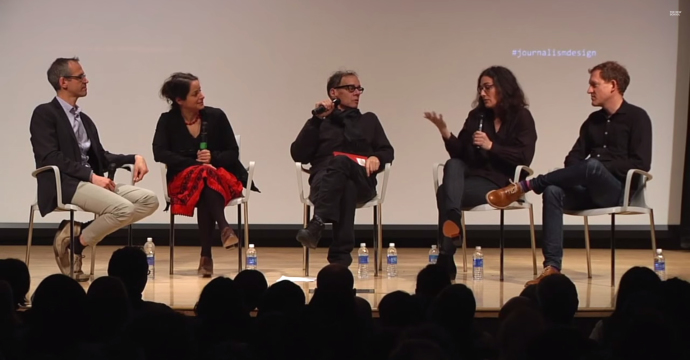An article on The New Yorker by Sarah Larson, “Serial,” Podcasts, and Humanizing the News profiles the power of audio journalism — particularly narrative non-fiction podcasts — to draw users into complex explanations with storytelling techniques. Media journalist David Carr had hosted the panel discussion with several new podcast producers — Sarah Koenig of Serial, Alex Blumberg of Startup, Alix Spiegel of Invisibilia, and Benjamen Walker of The Theory of Everything.
This piece makes clear the potential of audio journalism, storytelling techniques, and tech-distributed stories to engage audiences into very complex systems, making them clear through human voices, grounded stories, and an ongoing narrative arc.
Voices make audio journalism feel intimate. Listeners can feel that they actually know the people speaking and the subjects involved. “Serial,” which delved more deeply into one story than any popular podcast has thus far, felt especially so; Koenig was our guide through all twelve episodes, exploring a complex world of love and murder in a community of teen-agers and their families. We learned as she learned. “People feel like they know me, and they kind of do, in a way,” Koenig said on the panel. She got letters, e-mails, and voice mails—at home and on her cell phone—saying, “Hey Sarah! Hey Sarah!” We felt like we knew Adnan Syed, too.
Spiegel said, “ ‘Serial’ really made me feel different about how much detail people can handle.” She added that an “unbelievably intimate” series called “Love Hurts” on another podcast, “Strangers,” brought home how there were “opportunities here for depth” in audio journalism greater than she’d understood. Creators of podcasts, which are largely unregulated and independently funded, have been free to make up their own rules and to try new things in ways that public-radio journalists historically have not.
Later, Carr described how he had been impressed, and surprised, by an earlier work of Blumberg’s. “One thing that should not work on radio, but did work, manifestly, was, ‘Let’s take on the banking crisis,’ ” he said. “ ‘Let’s do a big step-back.’ And you came up with ‘The Giant Pool of Money,’ ” a 2008 “This American Life” episode about the mortgage crisis. “If you had asked me, I’d have told you, ‘That’s a terrible idea.’ ”
“I did tell you that,” Koenig said to Blumberg.
“I was like, ‘It’s an hour on mortgage finance!’ ” Blumberg said. He personally had been “obsessed” with the story, but wasn’t sure how it would work for radio: would it have emotion, characters, narrative? “We talked to everybody in the chain of mortgage craziness: the people being sold the loans, and the loans were being sold, and then sold up again, all the way up to Wall Street,” he said.
“I feel like you’re underselling it,” Koenig said. “It was, like, the first piece of journalism about the housing crisis that most normal people understood.” I nodded as she said this. I am a normal person, if normal means financially naïve, and listening to “The Giant Pool of Money” in 2008 was a revelation for me. For an afternoon, maybe longer, it all made sense.
Carr said that the Times had “sunk an enormous amount of resources” into reporting on the crisis, going for similar accessibility. “We turned Pulitzer Prize winners loose on it. It was just so frustrating to me. These bing-bongs from public radio came in and just killed it!”
Blumberg said that it had been exciting to realize that the storytelling strategies that Ira Glass had given them at “This American Life” could be applied broadly, to any topic.
Koenig said, “Well, not just any topic but a super-dry topic where tape”—audiotape—“doesn’t automatically come to mind.”
“If we can just get one more central banker on it…” Blumberg said.
The ideas about radio journalism that Glass taught them, they said, included having something at stake, having an element of surprise, having a larger story and smaller anecdotes that support it, and having moments of authentic emotion.
I’d been thinking about audio storytelling for quite a while, but that night its power struck me in a new way. If “Serial” could humanize a murder case, without sensationalism, and begin to shed light on the criminal-justice system, and make millions of people engaged with it; if “The Giant Pool of Money” could make even me understand the mortgage crisis; if “Invisibilia” could explain, quite clearly, the neural components of blindness and vision to the average person, and make them thrilling, what else could a podcast do? Audio journalism is not just intimate but conducive to intense focus—in part because we tend to listen when we’re not looking at a screen. And now that public-radio talents are being influenced by podcasts and creating new shows accordingly, journalistic rigor is being combined with freedom in ways we haven’t considered before.
A few days after the panel, the Maryland Court of Special Appeals decided to hear arguments, in its June session, about the case of Adnan Syed. Koenig and the show’s other producers are now considering topics for the show’s second season, which won’t be about Syed, but they haven’t ruled out doing a follow-up episode someday. I’d welcome that. Season One of “Serial,” ultimately, wasn’t a murder mystery—it was a human mystery, and an exploration of justice. We’d like to learn more. Podcasts, like life, can be open-ended.
After the panel discussion and a Q. & A. with the audience, Carr said to the panelists, in his gravelly voice, “I was excited to be up here with the likes of you.” They, and we, were excited to be there with the likes of him. He was the life of the party—ferocious, curious, funny, and warm. A week later, he was gone.
